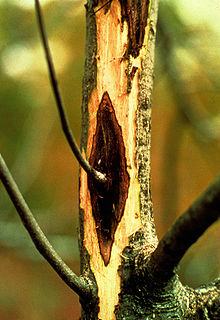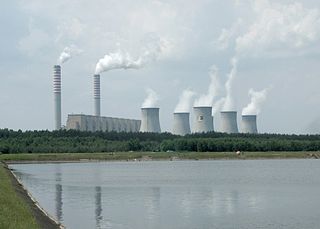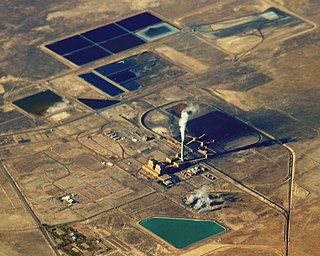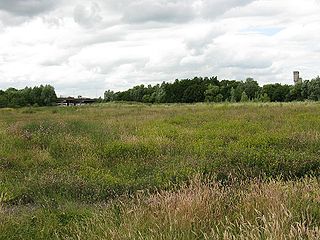
A plant canker is a small area of dead tissue, which grows slowly, often over years. Some cankers are of only minor consequence, but others are ultimately lethal and therefore of major economic importance in agriculture and horticulture. Their causes include such a wide range of organisms as fungi, bacteria, mycoplasmas and viruses. The majority of canker-causing organisms are bound to a unique host species or genus, but a few will attack other plants. Weather and animals can spread canker, thereby endangering areas that have only slight amount of canker.

Fly ash or flue ash, also known as pulverised fuel ash in the United Kingdom, is a coal combustion product that is composed of the particulates (fine particles of burned fuel) that are driven out of coal-fired boilers together with the flue gases. Ash that falls to the bottom of the boiler's combustion chamber (commonly called a firebox) is called bottom ash. In modern coal-fired power plants, fly ash is generally captured by electrostatic precipitators or other particle filtration equipment before the flue gases reach the chimneys. Together with bottom ash removed from the bottom of the boiler, it is known as coal ash. Depending upon the source and composition of the coal being burned, the components of fly ash vary considerably, but all fly ash includes substantial amounts of silicon dioxide (SiO2) (both amorphous and crystalline), aluminium oxide (Al2O3) and calcium oxide (CaO), the main mineral compounds in coal-bearing rock strata.

A fossil fuel power station is a thermal power station which burns a fossil fuel, such as coal or natural gas, to produce electricity. Fossil fuel power stations have machinery to convert the heat energy of combustion into mechanical energy, which then operates an electrical generator. The prime mover may be a steam turbine, a gas turbine or, in small plants, a reciprocating gas engine. All plants use the energy extracted from expanding gas, either steam or combustion gases. Although different energy conversion methods exist, all thermal power station conversion methods have efficiency limited by the Carnot efficiency and therefore produce waste heat.
A pulverized coal-fired boiler is an industrial or utility boiler that generates thermal energy by burning pulverized coal that is blown into the firebox.

Bottom ash is part of the non-combustible residue of combustion in a power plant, boiler, furnace or incinerator. In an industrial context, it has traditionally referred to coal combustion and comprises traces of combustibles embedded in forming clinkers and sticking to hot side walls of a coal-burning furnace during its operation. The portion of the ash that escapes up the chimney or stack is, however, referred to as fly ash. The clinkers fall by themselves into the bottom hopper of a coal-burning furnace and are cooled. The above portion of the ash is also referred to as bottom ash.
Green waste, also known as "biological waste," is any organic waste that can be composted. It is most usually composed of refuse from gardens such as grass clippings or leaves, and domestic or industrial kitchen wastes. Green waste does not include things such as dried leaves, pine straw, or hay. Such materials are rich in carbon and considered "brown wastes," while green wastes contain high in concentrations of nitrogen. Green waste can be used to increase the efficiency of many composting operations and can be added to soil to sustain local nutrient cycling.
Northern Power Station was located at Port Paterson in the Australian state of South Australia about 6 kilometres (3.7 mi) south of the city centre of Port Augusta. It was coal powered with two 260 MW steam turbines that generated a total of 520 MW of electricity. It was operated and maintained by Alinta Energy and was commissioned in 1985. Northern received coal by rail from the Leigh Creek Coal Mine, 280 km to the north. The plant ceased electricity production in May 2016 and decommissioned and demolished over the following few years.

Kingston Fossil Plant, commonly known as Kingston Steam Plant, is a 1.4-gigawatt coal-fired power plant located in Roane County, just outside Kingston, Tennessee on the shore of Watts Bar Lake. It is operated by the Tennessee Valley Authority. The plant is known for the Kingston Fossil Plant fly ash spill which occurred in December 2008.

A coal-fired power station or coal power plant is a thermal power station which burns coal to generate electricity. Coal-fired power stations generate over a third of the world's electricity but cause hundreds of thousands of early deaths each year, mainly from air pollution.

Raichur Thermal Power Station (RTPS) is a coal-fired electric power station located at Yadlapur D(Shaktinagar) in the Raichur district of the state of Karnataka, India. It is operated by the Karnataka Power Corporation Limited (KPCL) and was the first thermal power plant to be set up in the state. The power station was commissioned during various periods from 1985 and it accounts for about 70% of the total electricity generated in Karnataka.

The health and environmental impact of the coal industry includes issues such as land use, waste management, water and air pollution, caused by the coal mining, processing and the use of its products. In addition to atmospheric pollution, coal burning produces hundreds of millions of tons of solid waste products annually, including fly ash, bottom ash, and flue-gas desulfurization sludge, that contain mercury, uranium, thorium, arsenic, and other heavy metals. Coal is the largest contributor to the human-made increase of carbon dioxide in Earth's atmosphere.

The Stella power stations were a pair of now-demolished coal-fired power stations in the North East of England that were a landmark in the Tyne valley for over 40 years. The stations stood on either side of a bend of the River Tyne: Stella South power station, the larger, near Blaydon in Gateshead, and Stella North power station near Lemington in Newcastle. Their name originated from the nearby Stella Hall, a manor house close to Stella South that by the time of their construction had been demolished and replaced by a housing estate. They operated from shortly after the nationalisation of the British electrical supply industry until two years after the Electricity Act of 1989, when the industry passed into the private sector.

Leaching is the process of a solute becoming detached or extracted from its carrier substance by way of a solvent.

The Kingston Fossil Plant coal fly ash slurry spill was an environmental and industrial disaster that occurred on Monday December 22, 2008, when a dike ruptured at a coal ash pond at the Tennessee Valley Authority's Kingston Fossil Plant in Roane County, Tennessee, releasing 1.1 billion US gallons of coal fly ash slurry. The coal-fired power plant, located across the Clinch River from the city of Kingston, used a series of ponds to store and dewater the fly ash, a byproduct of coal combustion. The spill released a slurry of fly ash and water, which traveled across the Emory River and its Swan Pond embayment, onto the opposite shore, covering up to 300 acres (1.2 km2) of the surrounding land. The spill damaged multiple homes and flowed into nearby waterways including the Emory River and Clinch River, both tributaries of the Tennessee River. It was the largest industrial spill in United States history.

The Portrack Incinerator was a municipal waste incinerator and waste-to-energy power station situated on the River Tees at Portrack in Stockton-on-Tees in County Durham, England.

An ash pond, also called a coal ash basin or surface impoundment, is an engineered structure used at fossil fuel power stations for the disposal of two types of coal combustion products: bottom ash and fly ash. The pond is used as a landfill to prevent the release of ash into the atmosphere. Although the use of ash ponds in combination with air pollution controls decreases the amount of airborne pollutants, the structures pose serious health risks for the surrounding environment.

The Big Sandy Power Plant is a 268 megawatt (MW), natural gas power plant owned and operated by Kentucky Power Company, a subsidiary of American Electric Power (AEP), on the shores of the Big Sandy River near Louisa, Kentucky. It was established in 1963. It was formerly a coal-fired power plant, but was converted to natural gas in 2016.

Kahalgaon Super Thermal Power Station (KhSTPP)is located in Kahalgaon in Bhagalpur district of Bihar. The power plant is one of the coal based power plants of NTPC. The coal for the power plant is sourced from Rajmahal coalfield of Eastern Coalfields Limited. Source of water for the power plant is Ganga River.

The North Chennai Thermal Power Station is a power station situated about 25 kilometres (16 mi) from Chennai city. It is one of the major power plants of Tamil Nadu and has a total installed capacity of 1,830 MW (2,450,000 hp).

Reftinskaya GRES is the largest solid fuel thermal power plant in Russia. It is situated in Sverdlovsk Oblast,100 km north-east of Yekaterinburg and 18 km from Asbest. Reftinskiy town, which is home to 18,000 people, is situated 2.5 km from the GRES, which produces 20,000 million KWh annually. It has a total installed capacity of 3,800 and heat power— 350 GKh. Coal from Ekibastuz's coal field is used as the main fuel and the black oil is used as the starting fuel. GRES produces power with the bar «Outdoor switchgear -500 kV» on five power lines -500 kV and with the bar «Outdoor switchgear -220 kV» on five power lines -220 kV. The station supplies power to the industrial areas in Sverdlovsk, Tyumen, Perm and Chelyabinsk regions. The construction of the electric power station was started in 1963, the launching of the first power unit took place in 1970 and in 1980 – of the last one.
















